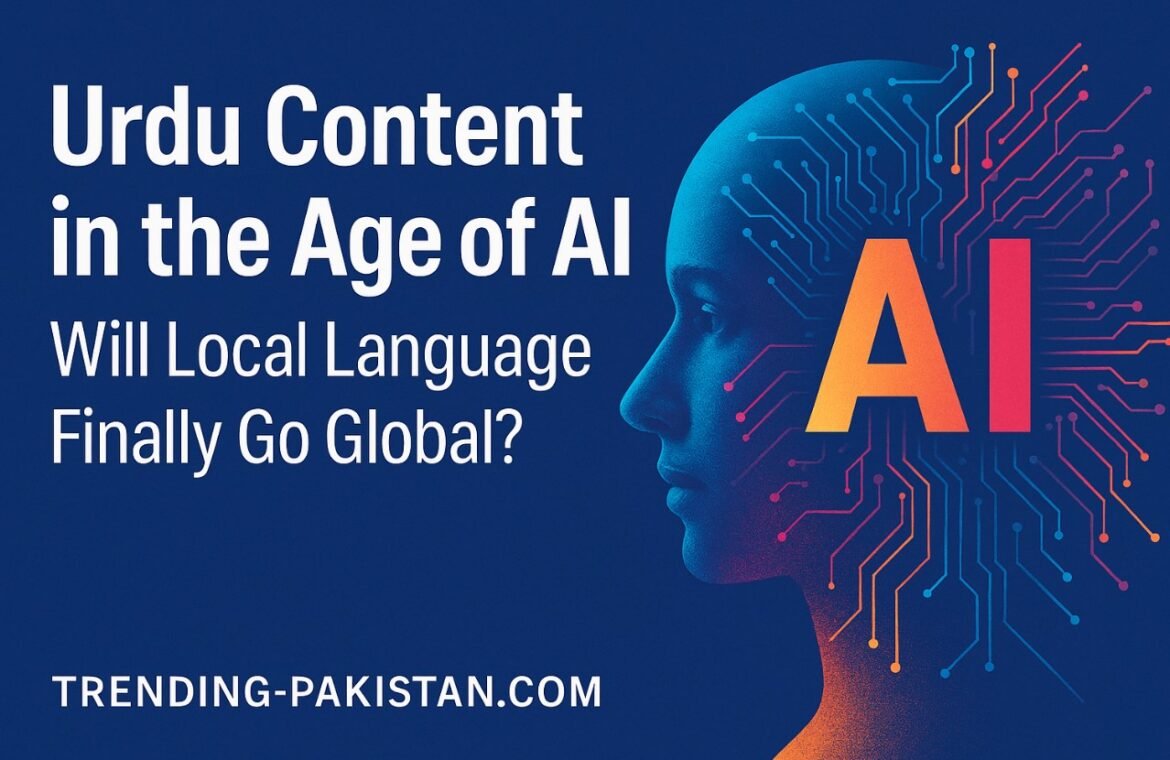For years, Urdu content lived in the shadows of the internet.
Search engines rewarded English blogs, advertisers chased English keywords, and even Pakistani creators were told:
“Write in English if you want to rank.”
But in 2025, that’s finally changing.
From ChatGPT to Google Gemini, from TikTok’s Urdu captions to voice-enabled search on Android, artificial intelligence is learning Urdu at record speed.
The result?
Urdu — Pakistan’s national language — is stepping onto the global digital stage for the first time.
Why Urdu Struggled Online for So Long
1. Search Engines Ignored It
For years, search algorithms were trained primarily in English. Urdu blogs were invisible simply because AI didn’t understand them.
2. Roman Urdu Confused Algorithms
“Main ja raha hoon” or “میں جا رہا ہوں”?
Mixed scripts and Roman Urdu made it difficult for search engines to standardize and index Urdu phrases.
3. Limited Monetization
Because most ads targeted English content, Urdu creators couldn’t earn through AdSense or brand collaborations.
This pushed bloggers and media outlets to stay English-only — even when their audiences weren’t.
How AI Is Changing the Game
AI has rewritten the rules for local-language content — and Urdu is finally being recognized.
1. Voice Search in Urdu
Pakistan’s smartphone boom and Google Assistant’s Urdu support mean millions now speak their searches.
“Lahore ka sabse acha biryani restaurant kahan hai?”
Businesses that optimize their sites for spoken Urdu queries are already seeing more visibility.
2. Generative AI Understanding Urdu
ChatGPT, Gemini, and Claude now understand, summarize, and even quote Urdu text.
This means Urdu articles can finally appear in AI-generated answers — from global Q&A platforms to search previews.
3. AI-Powered Translation & Localization
AI translation is becoming near-human.
Tools like DeepL, Google Translate, and Meta NLLB can now convert Urdu content into English, Arabic, or Hindi — making Pakistani blogs globally accessible with one click.
4. Inclusion in AEO & GEO
Answer Engine Optimization (AEO) and Generative Engine Optimization (GEO) — the new frontiers of SEO — are starting to prioritize multilingual answers.
If you’re writing in Urdu, AI search engines will finally find you.
What This Means for Pakistani Businesses & Creators
E-commerce Stores
Add Urdu descriptions alongside English.
Example:
“Best ladies kurta” → “خواتین کے بہترین کرتے”
It’s an instant boost in voice and visual search discoverability.
Bloggers & Influencers
Writing bilingual posts (Urdu + English) can double your audience.
Even ChatGPT and Perplexity AI will quote your content if formatted for AEO.
Media Houses
To stay relevant, Pakistani digital media must publish Urdu stories that are AI-indexable — clear, structured, and machine-readable.
Educational Platforms
EdTech startups using Urdu in AI-powered learning apps are reaching rural and lower-income audiences that were previously excluded.
Challenges That Still Exist
- Script Inconsistency
Mixing Roman and native Urdu still confuses AI and SEO crawlers. A unified writing style is key. - Lack of Skilled Urdu AI Editors
Most content teams are trained for English SEO. Pakistan now needs Urdu AEO specialists. - Risk of Mistranslation
AI still struggles with idioms, poetry, and cultural nuance — critical elements of Urdu expression.
The Road Ahead
Urdu is no longer a “local-only” language — it’s becoming a digital global language powered by AI.
With every new AI update, Urdu’s visibility grows.
What began as a struggle for recognition is now turning into a movement for representation.
For Pakistan’s creators, entrepreneurs, and storytellers, this is the moment to lead — to show that authentic, local voices matter as much as polished English prose.
AI may speak many languages —
but in 2025, it’s finally learning to speak ours.
Urdu content is finally ready to go global.
The combination of AI translation, voice search, and generative indexing means that Urdu creators can now reach audiences from Karachi to California.
The only question is — will Pakistani businesses and creators take the leap before the rest of the world catches on?
Top 5 AI Tools Supporting Urdu in 2025
AI isn’t just speaking English anymore — it’s learning Urdu.
From translation to content creation, these platforms are breaking language barriers and giving Pakistani users a voice in the global AI space.
Here are the top tools making it happen:
1. ChatGPT (by OpenAI)
Best for: Content creation, translation, and Urdu-language chats
ChatGPT now supports native Urdu input and output, allowing users to write, translate, or brainstorm in both Urdu and Roman Urdu.
Creators can use it for:
- Writing Urdu blog drafts or social captions
- Translating English product listings
- Generating bilingual (Urdu + English) content for better SEO reach
Tip: Use ChatGPT with “Custom Instructions” in Urdu for more natural tone and phrasing.
2. Google Gemini (formerly Bard)
Best for: Voice search, localization, and Google ecosystem integration
Gemini understands and responds in Urdu, especially across Android voice search, YouTube, and Google Maps.
For businesses, this means:
- Urdu queries (“Karachi ka best hotel kahan hai?”) now yield accurate local results
- Urdu voice commands can control devices and find businesses via GEO search
SEO Edge: Add Urdu and Roman Urdu keywords to your website and Google Business Profile for voice-search ranking.
3. Meta AI (Facebook, Instagram, WhatsApp)
Best for: Social media automation and Urdu engagement
Meta’s new AI assistant (rolling out in Pakistan via WhatsApp and Instagram DM) supports Urdu text and mixed-language chats.
Small businesses can use it to:
- Auto-reply to Urdu customer queries
- Generate caption ideas for Facebook and Instagram
- Translate ad copy for localized campaigns
Example: “WhatsApp bot likho jo Urdu mein customer ko timing bataye” — Meta AI can now do that.
4. Microsoft Azure AI & Copilot
Best for: Enterprise solutions and Urdu voice recognition
Microsoft’s AI stack — including Copilot for Office and Azure Cognitive Services — offers growing Urdu support in speech recognition and translation APIs.
Corporates and EdTech startups in Pakistan are using it for:
- Urdu voice-to-text transcription
- Automated call-center responses
- Multilingual chatbot training
Use Case: Banks and universities can deploy bilingual chat systems for customer service.
5. BaseH & Urdu.ai (Pakistan-based Startups)
Best for: Local NLP innovation and Urdu-first AI tools
Pakistan’s own AI innovators are stepping up.
- BaseH AI builds Urdu chatbots and digital assistants for government and SMEs.
- Urdu.ai focuses on optical character recognition (OCR), letting businesses digitize Urdu documents and PDFs.
Why It Matters: Local startups ensure Urdu’s unique grammar and cultural tone are accurately captured — something global models often miss.
Topics #AEO Strategy #AI in Pakistan #GEO for Urdu #Local Language Content #trending pakistan #Urdu SEO





